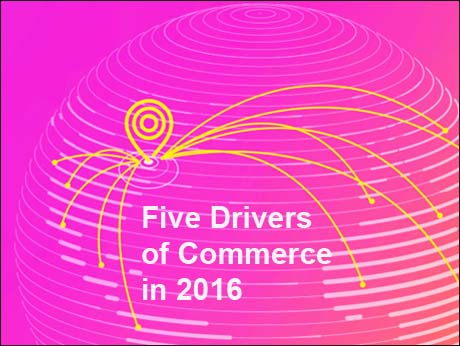
Towards 2016 -- 10 and last in our series
New Delhi, January 5 2016: Global technology provider of products and solutions to power commerce, Pitney Bowes, suggests five drivers of commerce for 2016.
Says Roger Pilc, Chief Innovation Officer : “Consumers are already demanding a more seamless way of integrating their physical and digital worlds. Businesses will need to transform their competencies to seamlessly serve customers across the physical and digital worlds of commerce."
1. The Internet of Things (IoT) technologies will drive better business outcomes across industries
When it comes to industrial businesses, the opportunity exists to leverage machine-to-machine and Internet of Things technologies, and extract and analyze data from industrial machines to drive better business outcomes. Industries across the board are experiencing a greater focus on creating and measuring operational efficiency in production settings. The business benefits include lower cost of operations, greater productivity and output and higher service levels. Businesses also need the flexibility to toggle between the physical and digital worlds to reach their customers in their preferred channels.
2. Small and medium businesses will greatly benefit from the digitization of physical communications
Significant shifts in technology, mobility and information are creating new global commerce opportunities for small and medium businesses. New tools and technologies enable small and medium businesses to better target, engage and serve new customers from around the corner to around the globe. These new technologies and cloud-based solutions are becoming available to integrate physical and digital experiences and simplify processes on one platform. Integrating physical with digital is reinventing mail, making it more interactive and more sophisticated. For example, businesses can now complement physical mail pieces with digital experiences through QR codes, create more interactive and targeted direct mail, and deliver messages across multiple channels to boost impact.
3. Personalization and hyper-localization will drive explosive growth in global commerce
As cross-border ecommerce becomes more mainstream, consumers are becoming savvier. Retailers and marketplaces must continuously improve the global consumer experience, but shopping experiences across the world are not all the same. The challenge facing retailers is to create deeper, more personalized localized experiences that resonate with consumers from varying countries and regions. To make international purchases not only possible, but probable, retailers must deliver what their global consumers want, while also taking into account how they like to shop.
4. Data Analytics will play a key role in fraud detection and prevention
The same data analytics in the Cloud that help create one view of the customer are moonlighting to fight crime, help meet regulatory requirements and detect fraud. Businesses across different industries – financial, insurance, retail, healthcare and public sector -- have the common interest in protecting their assets and minimizing their losses.
Personal identities, which are captured in the databases of retailers, insurance companies, healthcare providers, mobile phone providers and more, are almost always variable. Data quality solutions reconcile these variables and connect different personas to the same record, matched by a common address, in a simple, single view. This technology combats the many faces of fraud, while protecting a business against financial vulnerabilities and ensuring greater compliance. Physical and digital technologies must be aligned to protect consumers and their personally identifiable information. Integrated solutions that streamline regulatory compliance can help, as can address cleansing and database cleansing software.
Almost a quarter of security breaches involve accessing private data in paper-based form. New cloud-enabled multi-channel communications platforms are now available to help small and medium businesses ensure client data privacy, meet growing regulatory requirements and integrate their physical and digital transactional communications.
5. Omnichannel Marketing will increasingly use data analytics and optimize physical and digital technologies to deliver a seamless experience for the customer
An old strategy has new technologies that make 2016 the year of one view of the customer. Best next actions in any physical or digital channel will determine whether marketing wins the day or drops the ball. Marketing influences within the enterprise are looking for ways to lower costs and improve ROI. Making bills and statements more personalized, colorful, interactive, engaging, and more tightly integrated with digital channels, helps create more timely relevant and personalized messages for customers.
Customer service is at the heart of brand loyalty. In today’s technologically-advanced society, there are more opportunities for prospective and existing customers to communicate with a brand. Interactive and personalized video offers human-like communications that improve customer satisfaction, lower call center volumes and deliver higher customer retention rates